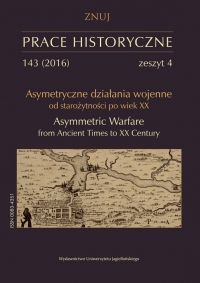Szlachcica portret własny. Autowzory osobowe w świetle wybranych polskich utworów autobiograficznych z XVII wieku
A self-portrait of a nobleman. Personal self-models in the light of selected Polish 17th-century autobiographical texts
Author(s): Urszula Świderska-WłodarczykSubject(s): Political history, Social history, 17th Century
Published by: Wydawnictwo Uniwersytetu Jagiellońskiego
Keywords: self-model; self-portrait; identity; authority; nobleman; autobiography; memoir; personal model and ideal; aristocratic axiology; Krzysztof Pieniążek; Jerzy Ossoliński; Jan Chryzostom Pasek
Summary/Abstract: The main purpose of this article is the analysis of the self-portrait of the nobility as presented in autobiographical literature. The analysis was based on four components typical not only of the period described, yet, taken together, determining a comprehensive self-portrait. These include: the fulfilment of genealogical conditions, which is associated with possessing one’s own crest; the theoretical and practical preparation for adult life – gained through education; the personal maturity manifested regardless of the stage of life, although with tolerance for some weakness – so typical of the teenage years; and finally the wealth, inherited and multiplied, although of various provenance, yet primarily used for the right purpose. The fulfilment of the genealogical conditions presented in the analysed autobiographies would be worth little but for the positive verification of the personality conditions based on internal excellence and morality built throughout life. They all enabled the existence of professional and even multi-professional conditions, like the noble’s right to and duty of a civil, parliamentary, diplomatic and military service, as well as working in one’s own belongings, for the benefit of the Republic. None of these, however, could occur, if not complemented by descriptions in the form of social conditioning. These asserted the involvement in the community’s life both on the micro and macro level, ranging from family relationships, friendships, neighbourhood or region, to national and religious community. These are the starting point and culmination of virtues such as patriotism and faith – certified individually and publicly. Such a kind of self-portrait of a nobleman was built by Krzysztof Pieniążek, Jerzy Ossoliński and Jan Chryzostom Pasek. At the same time, they ignored or misrepresented the biographical moments – especially Pieniążek and Pasek – which could depreciate the perfect picture. From a human point of view, those inaccuracies seem possible to excuse. In any case, however, they did not meet the standards of the era, the noble system of values, and hence the personal models and ideals. These standards testify as best as they can to the quality of the times that the Old Polish nobility had to live in.
Journal: Prace Historyczne
- Issue Year: 144/2017
- Issue No: 3
- Page Range: 459-479
- Page Count: 21
- Language: Polish

